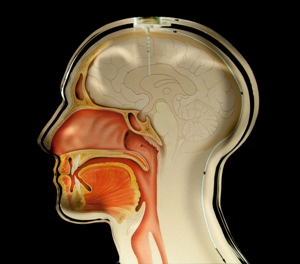Jan 2 2014
If the pressure in a patient’s brain is too high, physicians implant a system in the head that regulates the pressure. A sensor can now measure and individually adjust brain pressure. The sensor system is approved for use as a long-term implant.
 Physicians can measure cerebral pressure with the aid of implanted monitoring sensor. They merely place a hand-held reading device on the head of the patient. © Patrick J. Lynch / Fraunhofer IMS
Physicians can measure cerebral pressure with the aid of implanted monitoring sensor. They merely place a hand-held reading device on the head of the patient. © Patrick J. Lynch / Fraunhofer IMS
Urinary incontinence, a shuffling gait, and deteriorating reasoning skills are all indicators pointing to a Parkinsonian or Alzheimer type disease. An equally plausible explanation is hydrocephalus, commonly known as “water on the brain.” With this diagnosis, the brain produces either too much cerebral fluid, or it cannot “drain off” these fluids with adequate sufficiency. The consequence: Pressure in the brain rises sharply, resulting in damage. A shunt system – a kind of silicon tube that physicians implant into the patient’s brain, provides relief. It draws off superfluous fluid from there, for example, into the abdominal cavity. The heart of this shunt system is a valve: If the pressure increases above a threshold value, then the valve opens; if it declines again, then the valve closes.
In rare cases, over-drainage may occur. The cerebral pressure lowers too much, the cerebral ventricles are virtually squeezed out. Until now, physicians could only detect and verify such over-drainage through elaborate and costly computer and magnetic resonance tomography.
Cerebral pressure measurable anytime
With a new kind of sensor, things are different: If it is implanted into the patient’s brain with the shunt system, the physicians could read out brain pressure using a hand-held meter: within seconds, anytime and without complex investigation. Researchers at the Fraunhofer Institute for Microelectronic Circuits and Systems IMS in Duisburg, working jointly with Christoph Miethke GmbH and Aesculap AG, engineered these sensors.
If the patient complains of discomfort, then the physician merely needs to place the hand- held meter outside, on the patient’s head. The device sends magnetic radio waves and supplies the sensor in the shunt with power- the implant is “awakened,” measures tem- perature and pressure in the cerebral fluid, and transmits these data back to the handheld device. If the pressure on the outside of the desired area, the physician can set the valve on the shunt system from the outside as needed, and individually adjusted to the patient. “The sensor is an active implant, which also takes over measurement functions, in contrast to a stent or a tooth implant,” says Michael Görtz, head of pressure sensor technology at IMS.
The implant must be biocompatible; the body cannot reject it. Researchers had to ensure that the body also would not attack the implant. “The defense response behaves just like an aggressive medium, that would even dilute the silicon of the electronics over the course of time,” explains Görtz. Miethke therefore completely encases the implant into a thin metal casing. “We can still supply it with power from the outside through the metal casing, measure cerebral pressure through the housing and transmit the recorded data outside, through the metal to the reader,” Görtz explains. To do so, the correct metal had to be found. The coating may not be thicker than the walls of a soft drink can – in other words, much thinner than one millimeter. The researchers even developed the handheld reading device, together with the electronics, through which it communicates with the sensor.
The sensor is ready for serial production, and was already approved by Miethke. The company has already initiated the market launch of the system. “The sensor sets the basis for the further development through to theranostic implants – a neologism derived from the words “therapy” and “diagnostic.” In a few years, the sensor could then not only record cerebral pressure and develop a diagnosis on the basis of this, but also properly adjust the pressure independently, immediately on its own and thus, take over the therapy process,” says Görtz.